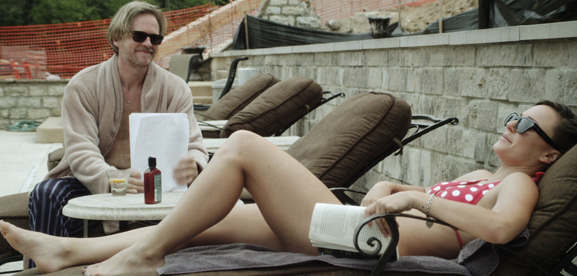 She Loves Me Not, which premiered Sunday on the closing night of “Dances With Films,” tells three separate stories of a man in crisis. Or is it one story, in three parts? Either way, it features Cary Elwes as an alcoholic writer, so it’s hard to go wrong.
She Loves Me Not, which premiered Sunday on the closing night of “Dances With Films,” tells three separate stories of a man in crisis. Or is it one story, in three parts? Either way, it features Cary Elwes as an alcoholic writer, so it’s hard to go wrong.
Our introduction to Elwes’ character comes before we’ve really had a chance to hear him speak or even see him that clearly. He wakes up on the couch in his enormous home, clearly hung over . . . and the first thing he does is reach for and drain a nearly empty liquor bottle. This sets the tone for the rest of the film. Dilapidated, with a beard that looks to be more the product of not caring enough to shave than an actual fashion statement, Elwes’ Brady Olinson is a “Drink first, ask questions later” kind of guy.
The film then follows him through three different episodes in his life, as he struggles, slowly but surely, to pull himself out of the hole he’s managed to dig over the last few years of his dwindling career. Each segment features a different style, a different genre—and a different woman who doesn’t love him.
Up first is “The Assistant.” Gorgeous, twenty-something Charlotte (Briana Evigan) works for Brady as his assistant and lives with him in that gargantuan house, which is in the midst of being remodeled. What exactly she does for him is unclear, since she’s never actually shown doing it—nor does it seem that Brady could make her. Their relationship isn’t employee/employer, nor is it mentor/student. The two are clearly on equal footing, talking as old friends—meaning they each say what they think of the other and don’t hold back.
Once the author (under a pseudonym) of a hugely popular set of novels, Brady has been less successful in recent years. He’s supposed to be working on a new book, a comeback in a new genre, but hasn’t written a word of it. It seems unlikely that he even leaves the house much (90% of the movie takes place in and around it), or talks to much of anyone, or does much of anything besides drink. So, Charlotte is really the only person around who can give him a much-needed reality check. In that respect, their relationship is oddly reminiscent of Jubal Harshaw and his three quick-witted secretaries from the book Stranger in a Strange Land. Elwes and Evigan have good chemistry, with a back-and-forth rapport, and tension cut with a bit of biting humor.
The second segment is “The Publicist.” Some time has passed—probably a year or more—and Charlotte has gone on to (hopefully) bigger and better things elsewhere. Remodeling of the house has ceased in the middle, due to a lack of funds. But, Brady has finally finished his new book, and sharp, New York businesswoman Marcy (Caitlin Keats) has come to the house to discuss promoting it. But, there’s also another, less savory issue at hand, beneath the simple business talk. Eerie, dramatic music gives this whole segment a creepy and suspenseful air, which is highlighted by a performance by Karen Black as Brady’s mysterious and sinister maid. It’s amazing what a few ominous chords do for this section’s entire tone.
And, finally, there’s “The Keeper.” It’s another year or more later, and Brady has finally decided to sell his monstrous house and hopefully move into one that won’t require a map to get from one end to the other. Only he’s still not quite ready to leave. His realtor (Joey Lauren Adams) has been trying for a year to find a buyer, only to have Brady sabotage the attempts and scare people off by hanging around the house.
All-in-all, it’s a good film, and entertaining. Cary Elwes, effecting a gravelly and dissipated American accent, is the clear standout performance, but each of the women opposite him is able to hold her own. And, it’s very interesting, rather than viewing the gradual progression of Brady’s character arc, to see it in snapshots, with most of his major life changes occurring in the interim, rather than being dramatized.
The house and grounds are beautiful, but at the same time really convey the loneliness of having one person living in this enormous space. The house serves as a metaphor for the whole movie, and Brady’s relationship to it is a major facet of his character over the course of the film. In fact, it was the house itself that inspired the film, with the owner approaching the filmmakers with it as a possible shooting location, which they then designed the film around.
One minor flaw, though, is in the whole “multiple genres” aspect. The filmmakers have said that they wanted each segment of the movie to be done in a different genre. They even allude to it in the film itself, with Brady talking about how he wants to “switch genres” with his new book. The problem is that the genres of the first and third segments aren’t really very clearly defined. Their tones are different, certainly. And, their styles, particularly since the third segment had a different writer/director. But, the only segment that makes a sharp distinction in genre is the second, with its mystery/suspense overtones. Without it, you wouldn’t really notice the difference.
Still, it’s a minor flaw. It’s a good, well-made movie that provides a unique experience. And, that’s worth watching in any genre.

